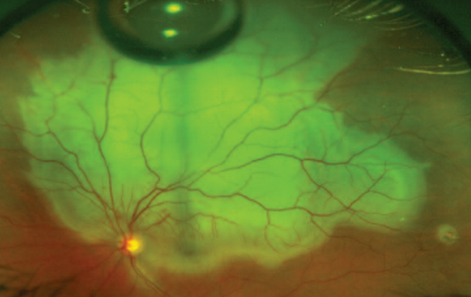optomap® Helps Guide Laser Treatment for Retinal Toxicity Issue
A young woman with a history of depression, drug & alcohol abuse was seen in a Houston clinic after injecting isopropyl alcohol into her left eye. According to the patient, her eye was bothering her and she believed the rubbing alcohol would help. She went to the clinic due to a loss of vision in the eye she injected.

Source: Optos
Examination
Visual acuity in 20/20 right eye and hand movement at 2 feet in the left eye. Intraocular pressure was 13/12 by applanation. A dilated retinal exam was performed with findings of retinal infarct, vascular pruning and a few intra-retinal hemorrhages, macular edema, rare vitreous cell and possible operculated hole at 3:00. An optomap was taken and confirmed an operculated hole and air bubble with a small hemorrhage superiorly, near the hole where patient performed the self-injection. The imaged confirmed the diagnosis of retinal toxicity, vascular ischemia, hemi-retinal artery occlusion, macular edema and a retinal hole.
Discussion
The risks, benefits and alternatives of treatment discussed with patient and father. The father consented to laser treatment and a grid laser was performed. The patient was admitted to hospital for a psychiatric evaluation following the laser treatment. Four days post laser treatment, the exam showed no visual acuity changes, the vitreous had cells and an optomap was performed, which documented that the air bubble was gone, grid laser treatment stable and a small hemorrhage at edge of laser treatment, which will reabsorb with time.
Conclusion
The ultra-widefield optomap documented the far peripheral hole with this challenging patient and also helped guide the laser treatment. A conventional camera image would not have been able to capture the hole. It is likely that eye steering with a camera would not have been possible due to the condition and cooperation of the patient.
optomap can also help you with guiding treatment options for better patient outcomes.
Contact us to learn more about partnering with Optos to benefit your patients and your practice.